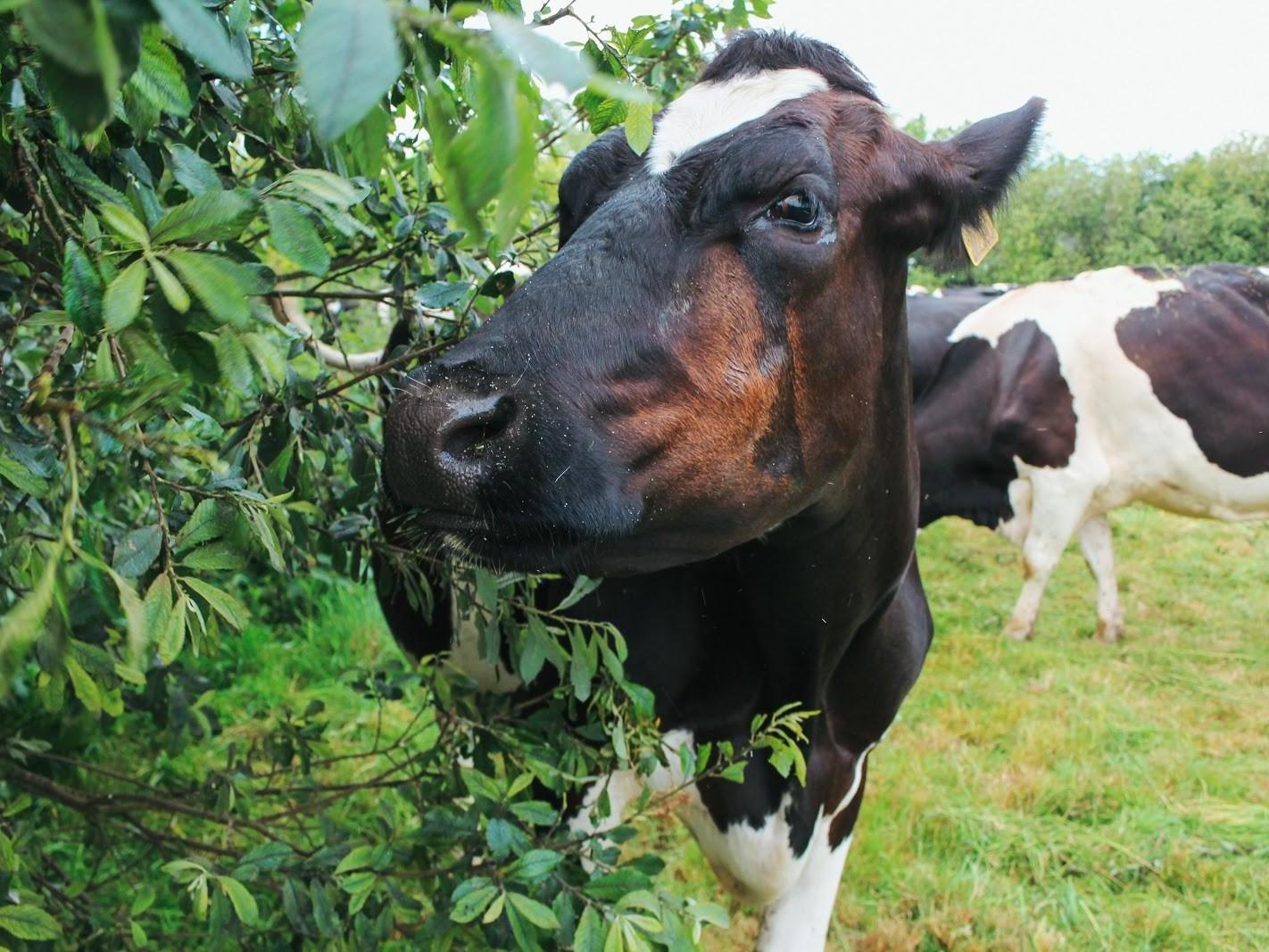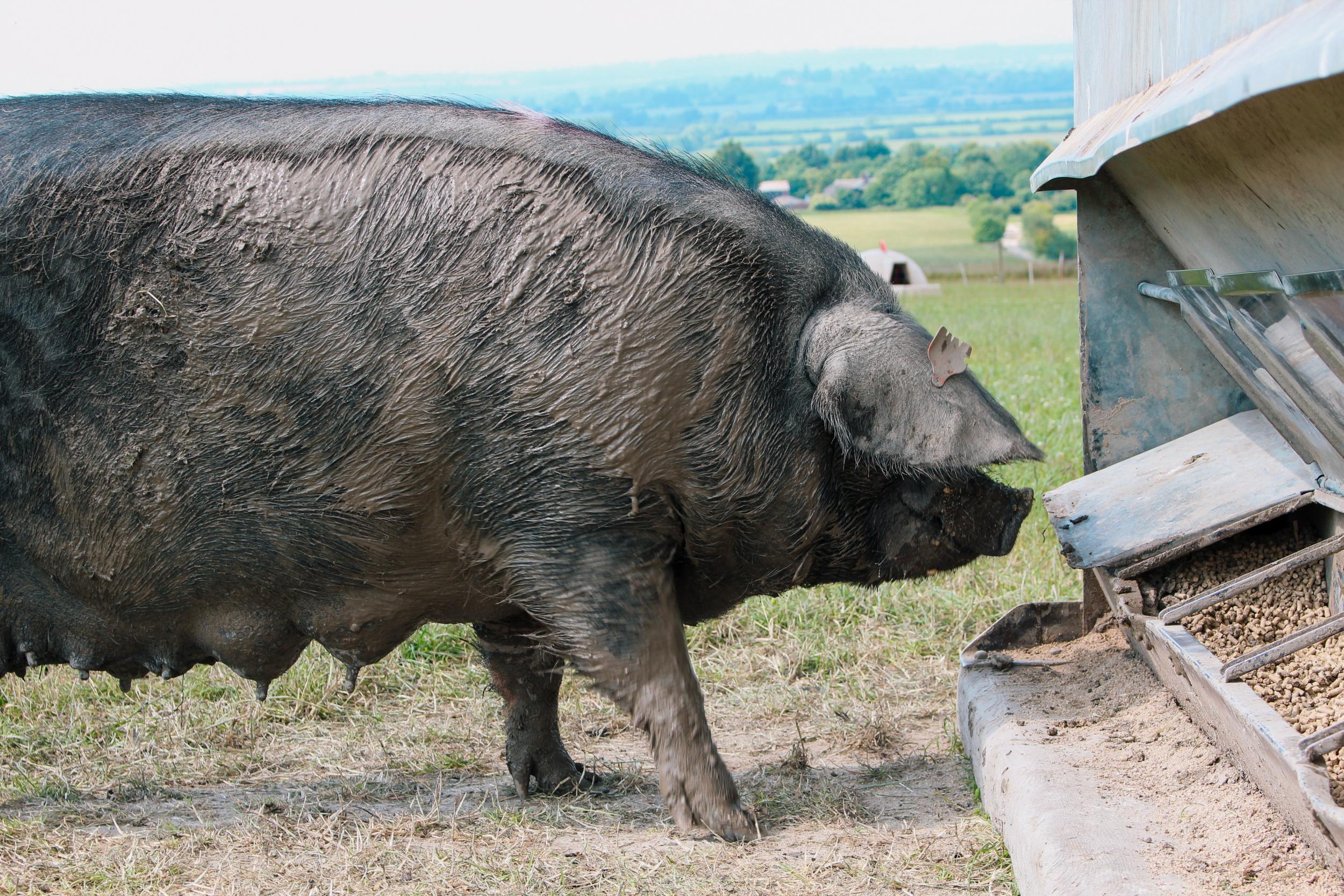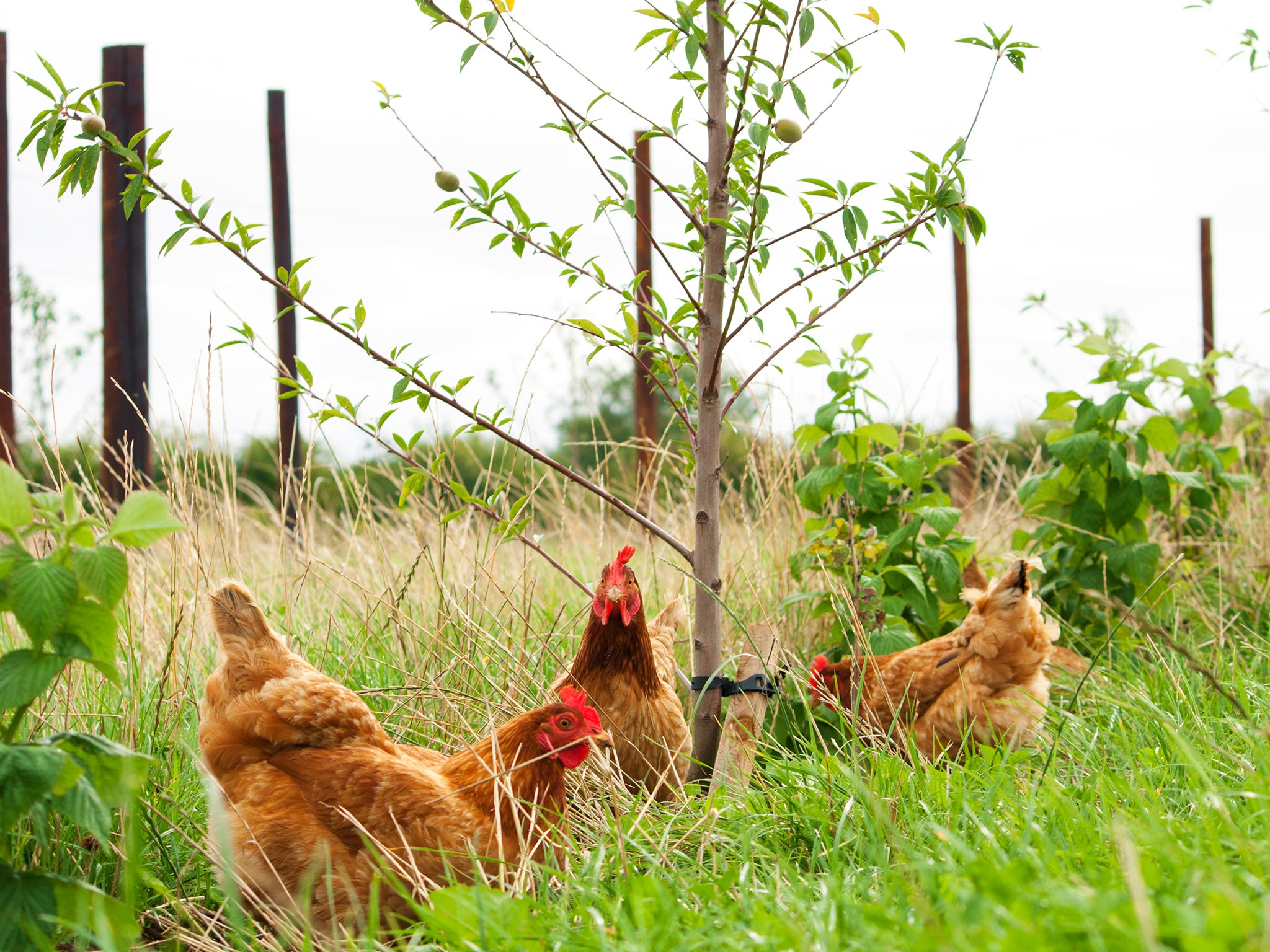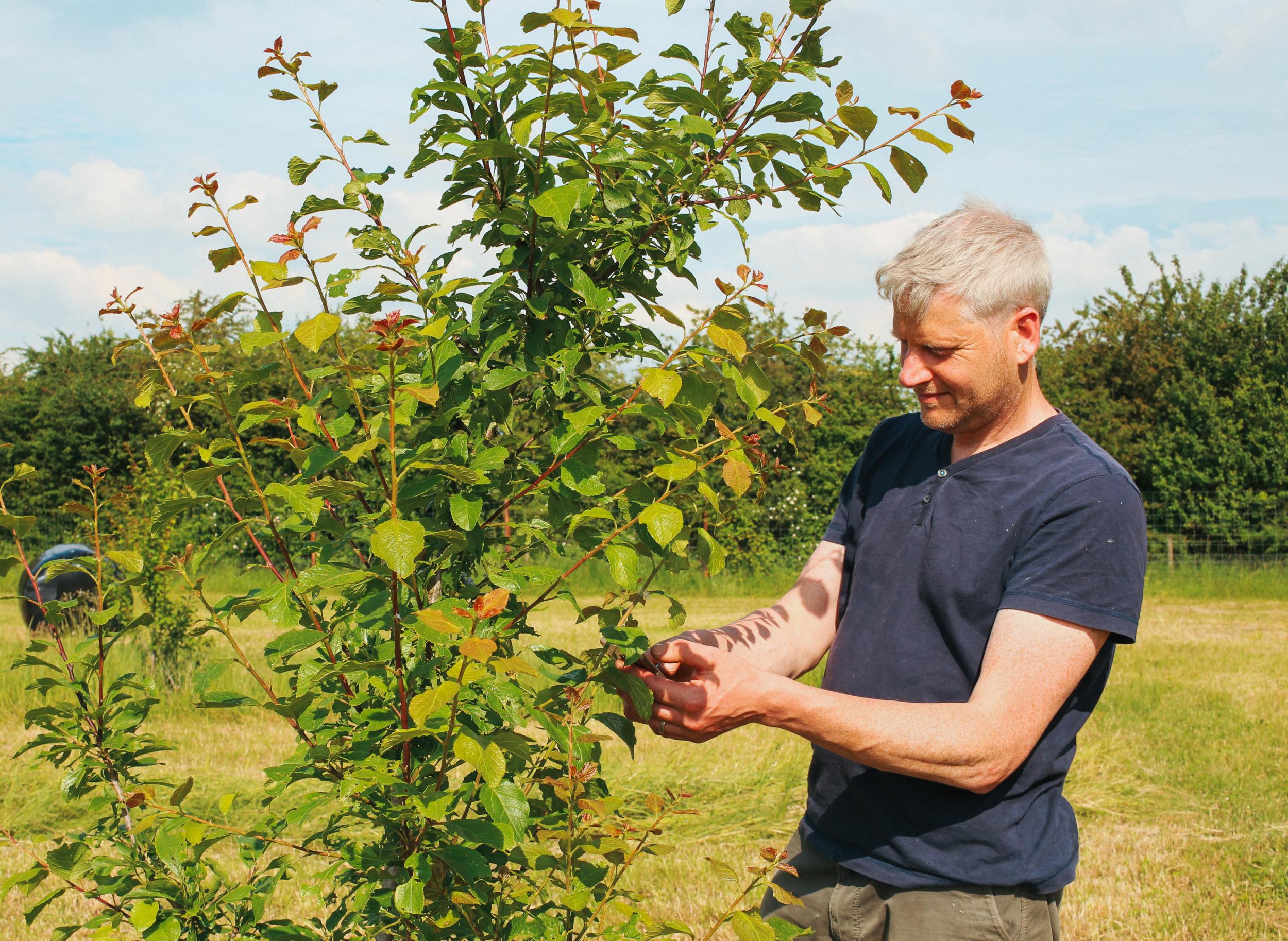If ewe go down to the woods: Why planting trees on farms is exactly what animals, crops and the climate need
The ancient symbiosis of beasts roaming forested land is being reintroduced to our fields – albeit in modern ways that are more likely to involve chickens and raspberries than wolves and alder, writes Emily Clark


In a field somewhere in Wiltshire, there is an unassuming row of raspberry canes growing in a grassy, weed-tangled patch with a happy tale to tell. The summer before last, this plot would have been filled with the sound of 70 laying hens clucking as they roamed about, scratching at the weeds around the raspberries.
As part of this hen-and-berry experiment, some canes had been fenced off. The chickens, like tiny bio-tractors, went about delivering nutrient-rich manure to the land around the other plants. The hens benefited from freedom and green space. And the raspberry canes they visited? They grew quicker and fruited earlier than the ones beyond the fence boundary. Even now, after nearly two years without chickens, they are still much better plants.
Alas, this story doesn’t end quite so well for the hens. Their merry outdoor tramping proved too tempting for kites, buzzards and kestrels, and several were plucked right out of raspberry paradise and eaten up.
Nevertheless, this experiment was worthwhile – it is an example of the mixed style of farming that could help our crops, farm animals and soils thrive.
There is a word for this method and it’s buzzing across Britain’s fields: agroforestry. If you listen to The Archers, you’re probably thinking that you’ve heard about it on there. If you don’t, you’re probably thinking about how unbearable The Archers is.
For the anti-Ambridge brigade, agroforestry is when farmers plant trees (or shrubs and bushes like raspberries) in their fields – and it can help solve many of the problems facing our farmers.
Soil erosion is one of the most concerning. This happens when soil is washed and blown away by rain and wind. Some 3 million tons of topsoil are lost in the UK each year, according to the Campaign to Protect Rural England. And British soils may have only 100 harvests left, warn scientists from the University of Sheffield.
But trees protect soil: their roots provide stabilising infrastructure, creating channels where water is held, while their bodies act as wind-blockers. These factors will come in even more useful with the increasingly violent floods and storms caused by climate change. In a few decades’ time, we may be relying on agroforestry techniques just to ensure we can still feed ourselves.
The roots of trees also dig deeper than crops, allowing them to bring up more nutrients – mainly nitrogen, phosphorus and potassium – from below. The nutrients spread to the leaves, which then fall on the soil and feed crops, if they are being grown alongside. This is nature’s fertiliser and could help farmers cut their pesticide costs as well as revitalise tired, one-crop fields.

Trees also provide habitats for wildlife down in the earth’s crust and above it – giving home to the birds, critters and insects that are in alarming decline in Britain, whose existence we depend upon for our ecosystem.
And crucially, trees suck up carbon, which is why planting them is key to the government’s climate strategy. More and more, trees are hitting headlines as solutions to our climate crisis. The government advisers at the Committee on Climate Change say 30,000 hectares of woodland should be planted every year until 2050 to meet the UK’s goal of net zero carbon at that point. That’s 1.5 billion trees in total.
Farmers have come to see trees as a problem rather than something of value. If you’ve got a big oak tree in the middle of your field, you don’t think, ‘It’s great to have a habitat for all the stuff around oak trees’, you think, ‘I’ve got to bloody drive round that in my plough’
The committee, made up of science and business experts, adds that the 30,000 hectare figure may have to be revised up to 50,000 if other climate promises aren’t met.
Last year, England was 7 million trees short of the target for just 5,000 hectares, so there will have to be huge changes to keep us on track – putting agroforestry in the spotlight. It’s likely that the benefits of tree planting will align with the environment-focused farming subsidies that replace the EU payments after Brexit.
There are still more benefits from farm trees – animals allowed to graze among them are given shade and shelter. This means they need less feed to keep warm or cool, and gives them a wider diet. The fruit, nuts, fuel logs or timber from trees and bushes then create another income stream for farmers.
With all this, you would think farmers would be keen on agroforestry. But modern farming, which has crept up on us since the industrial revolution and inspired today’s chemical-soaked monocrops, has seen farmers become reluctant to keep hedges, bushes and trees.
Many tore these wilder spaces up so they could profit from crops instead – every inch of field matters when margins are tight. In our mad farming subsidy matrix, which encourages farming with yield-boosting pesticides, who could blame them? (Tearing out long farm hedgerows did become illegal in 1997.)

Our version of capitalism has also created incentive to farm lots of one thing – high street chains and supermarkets want to make life easy for themselves by having fewer suppliers who can deliver bulk orders. But eventually, the huge monocrop fields that are fuelled on chemicals will become infertile, and what then?
The good news is that, if done carefully, planting trees can boost productivity by up to a third, according to the Soil Association (SA). It can be done in an environmentally sustainable way that also makes financial sense.
When cows munch on tree leaves, their diet is improved and tree growth is stimulated – mulberry leaves are high in protein and willow bark has painkilling properties. Or when chickens trample down the weeds around young trees, they are stifling the competition. As with the hens and raspberries, animal manure then fertilises the soil – helping trees or crops grow.
Farmers were being paid to rip out hedges so that fields got bigger. As a result we’ve now got lots of really big fields, with nothing but one crop in it, which is actually quite a vulnerable, fragile position to be in
But before taking the risk of buying trees and rethinking their farm systems, farmers need sound advice to know what’s best for their animals or crops. There are a million agroforestry variations, and a million factors – soil type, tree species, choice of animal, grazing time, fencing, market demands, wind direction, labour costs, stubborn landowners… pass the paracetamol.
This is a long game, and the financial stakes are high – it can take 10 to 15 years to establish a raspberry cane, and growing oak for timber can take 100 years.
But there is advice out there. Ben Raskin, head of horticulture at the SA, is in his third year of testing out more than 20 tree species at Eastbrook Farm in Wiltshire – belonging to SA chief executive Helen Browning. He oversaw the raspberry and chicken combination, just one example of his many devious schemes.
He’s particularly excited about growing almonds and apricots (now feasible thanks to global warming) in a location that hasn’t been tried before… in other words, California dreamin’. Raskin has now put together a handbook for farmers explaining how to move into agroforestry, produced by the SA and the Farm Woodland Forum.
He says at least one farmer a week comes over to ask about his agroforestry experiments – four came the week before I visited, with 1,000 acres between them, and officials from Defra were booked in the following week.

Before showing me his neat rows of young trees including peach, pear, cherry and damson, he explains why this type of farming is blossoming in Britain – after 150 years of decline.
“Long, long ago, farmers would have made quite a lot of use of trees, and hedgerows would have been quite productive,” he says. “They would have had fruit and nuts and they would have coppiced them for fuel.”
As industrialisation took hold, and farmers began to specialise, the story changed. “We were getting bigger tractors and becoming more efficient at farming,” Raskin says, “so farmers were being paid to rip out hedges so that fields got bigger. As a result we’ve now got lots of really big fields, with nothing but one crop in it, which is actually quite a vulnerable, fragile position to be in.
“Farmers have come to see trees as a problem rather than something of value, something that’s worth spending time on. If you’ve got a big oak tree in the middle of your field, you don’t think, ‘It’s great to have a habitat for all the stuff around oak trees’, you think, ‘I’ve got to bloody drive round that in my plough’. However, trees do bring a whole massive range of benefits to a farm.”
A lot of countries are way ahead of us on this, he says, including France, China, America and tropical countries that never lost the art. In Spain and Portugal’s dehesa systems, pigs are mixed in with cork and oak trees, feeding on the acorns.
Raskin points to a few agroforestry operations in the UK – the Pontbren lamb project in Wales involving 10 farmers is one that has been a particular success. They realised during the Nineties that they were spending too much on feed and housing costs for their lambs. To keep the lambs outside for longer, they knew the animals would need more shelter – so they began planting thousands of trees.
Their plans worked. But the farmers also realised that the woodland absorbed 60 times more water than pasture fields just 10 metres away. The trees they had planted in the wettest parts of Wales were a brilliant defence against flooding in other parts of the country.

There were also fewer chemicals running into waterways from compacted soils on intensive farms. And better shelter is known to reduce flock health issues, such as lameness or even death of the youngest lambs.
But Raskin says there are still very few examples of agroforestry in the UK – and we’ve got to up our game.
With the barrage of difficulties faced by our farmers, especially as Brexit uproots the subsidy system, they’re going to need all the help they can get. Trees might be the perfect way to branch out.
Join our commenting forum
Join thought-provoking conversations, follow other Independent readers and see their replies
Comments
Bookmark popover
Removed from bookmarks